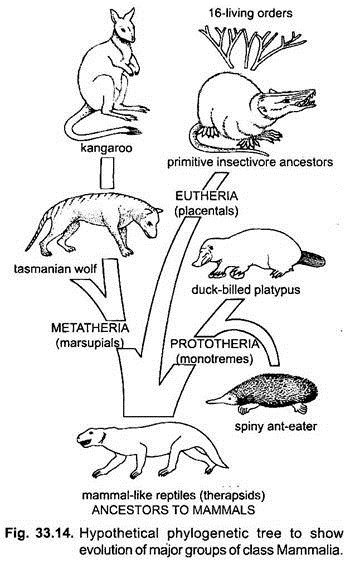There can be no doubt that the earliest mammals made their appearance in Jurassic times as descendants of some of the true mammal-like reptiles, the Therapsida.
However, scientists put forwarded two important ideas- Ancestry through Amphibia and Ancestry through Reptilia about the origin and ancestry of mammals.
Ancestry through Amphibia:
It was T.H. Huxley (1880) who advocated amphibian ancestry of mammals.
The points on which Huxley based his arguments were:
ADVERTISEMENTS:
(a) Presence of two occipital condyles in the skull of both Amphibia and Mammalia,
(b) Presence of left aortic arch in mammals.
However, Huxley’s theory is not tenable because occipital condyles are derived from exoccipitals in Amphibia but from basioccipitals in Mammalia. Apart from this, the two classes have different modes of life and exhibit many fundamental differences.
Ancestry through Reptilia:
Palaentological evidences establish the fact that mammals arose from reptiles. This view also gets strong support from the fact that the monotremes (primitive mammals) and living reptiles have close resemblances in their anatomical features including soft as well as hard parts.
Ancestral Mammal-Like Reptiles:
ADVERTISEMENTS:
Fossils of Synapsida that have been discovered in the Carboniferous strata indicate many characters leading to mammalian line. They lived throughout the Permian and Triassic periods, dating back 280 million years or more. The more mammal-like synapsids belonged to the order Therapsida.
One of the more advanced carnivorous therapsids (suborder Theriodontia) was called Cynognathus (dog jaw). It lived during the early Triassic period.
It was wolf-sized and showed the following mammalian characters:
(i) The presence of two occipital condyles which develop from two exoccipitals, and enlarged lateral temporal fossa.
ADVERTISEMENTS:
(ii) A well-developed secondary or false palate which separates the nasal passages from the mouth cavity.
(iii) Heterodont dentition with teeth embedded in sockets and differentiated into small peg like incisors, elongated canines, and cusped molars.
(iv) The quadrate of the skull and the articular of the lower jaw forms a joint, but both of them are reduced in size, thus, foreshadowing the beginning of squamosal-dentary joint of the mammals.
(v) The dentary of lower jaw is greatly enlarged and other reptilian bones of the lower jaw reduced or altogether absent.
(vi) The scapula at its front border was everted or turned out which is the beginning of the scapular spine of the mammals.
(vii) The number of phalanges in the digits are reduced to two in the thumb and great toe, and three in all others.
(viii) The sacrum and consequently the ilia are elongated, the latter in the form of anterior iliac blades.
(ix) Typical upright mammalian limbs capable of generating considerable speed.
All the aforesaid characters point unmistakably to the fact that the ancestors of the mammals are the Therapsid reptiles.
ADVERTISEMENTS:
Therapsids retained several reptile-like features also. Their skull was intermediate between that of reptiles and mammals, having small cranium, parietal foramen, single middle ear bone, reduced quadrate and quadratojugal, many lower jaw bones, etc. It is also not known whether therapsids were warm-blooded, had hairs instead of scales and nursed their young. They were not necessarily the direct ancestors of present day mammals.
First True Mammals:
There is very little evidence from the fossil remains, mainly teeth and jaws, which reveal very little about the first true mammals. They were mostly tiny creatures no longer bigger than rats and mice and insignificant. But they could still manage to survive by exploiting different ways of life from those practiced by the contemporary gigantic reptilian enemies.
They were nocturnal, thus, avoiding direct conflict and competition with the mostly diurnal reptiles. They were either burrowing hunting for insects, or arboreal in contrast to their ground-dwelling herbivorous or carnivorous contemporaries. They had a regulated high body temperature (endothermic), hairy integument, and probably earned their young in pouches for further development after birth, and safety. They were provided with larger brains and greater intelligence.
By the end of Cretaceous period (Mesozoic age) the vast majority of dominant reptiles became extinct for reasons which are still not understood well. Many ecological niches were now left open to mammals who started their great adaptive radiation.
By the close of Cretaceous period, placental mammals became extinct from marsupials. During Coenozoic age, there were established all the orders of placental mammals, so that it is called the Age of Mammals.
Polyphyletic Origin:
Living mammals are divided into two different reproductive subclasses. The primitive reptile-like egg-laying (oviparous) monotremes are in the subclass Prototheria. All other mammals give birth to living young (viviparous) and form the subclass Theria. The living therians are divided into marsupials or infraclass Metatheria, and placental or infraclass Eutheria (Fig. 33.14).
Whether mammalian evolution is monophyletic or polyphyletic? Nothing is known about the origin of primitive Prototheria, for fossils older than Pleistocene are unknown. They have remained primitive probably due to isolation from rest of World in Australia and New Zealand. During Jurassic period, there were atleast 5 well-established orders of mammals, now all extinct.
According to the phylogeny given in Fig. 33.14, origin of mammals is polyphyletic because they derive from atleast two Triassic reptilian stocks, cynodonts and ictidosaurs. It is generally assumed that the living Prototheria possibly evolved from the docodonts, while Metatheria and Eutheria evolved independently from the pantotherians, by the end of Cretaceous period.
